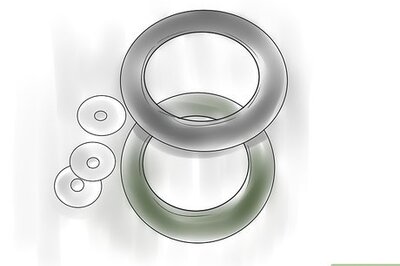
views
Understanding how debate works

Know how to dress and present yourself. When you attend a debate tournament, it is not uncommon to dress nicely. For the guys, this means a button-up shirt with some slacks or khakis and probably a tie. As for shoes, it is wise to wear black or brown dress shoes. The more professional you look, the better chance you have at winning the ballot. For the ladies, you may want to wear a nice dress, slacks or a business skirt. As for shirts, you could wear a button-up one with a tie, or go for a dress shirt with a black cardigan or suit jacket. It all depends on what you feel comfortable in. A good majority of female debaters wear heels but flats look just as presentable and won't hurt your feet as badly. When you walk into the debate round, if you look nicer and more presentable than the other team, you already have a better chance at winning the ballot.

Know how to walk into the room and greet the other team/judge. It is always a good idea to find a spot in the room where you can see how the judge is reacting to the speaker. It isn't as important that you see the speaker. Most judges react to what the speaker is saying, so you can tell what they are thinking. After you pick the spot you are going to sit within the round, you need to greet the judge. Shake their hand and smile before you sign the ballot. After you sign the ballot, greet the other team and shake their hands also. Then you and the other team need to agree on a place to speak from. It is always a good idea to make sure it is easy for the judge to see and hear you while you speak, so keep this in mind when picking where you are going to speak from.

When leaving the room after the round, thank the judge for his/her time. Shake your opponents' hands and tell them good gob. Never leave the room before the other team, especially if the judge is still present. If you leave before the other team and they are left in the room with the judge, it is likely that they will talk to the judge after the round and it could result in you losing because of something they said. It is always a good idea to remain in the room.

Know the speaker order, so that when it is your turn, you can be ready. The speaker order is as follows: 1AC- 2N CX, 1NC- 1A CX, 2AC- 1N CX, 2NC- 2A CX, 1NR, 1AR, 2NR, 2AR.
Knowing how to debate

Expect your coach to teach you this part in time. However, at its most basic, be aware that every year the debate community is presented with a resolution. The affirmative team has to follow this resolution and present a way that the status quo could be improved within the resolution. The negative team then argues back, stating how the status quo is better and if we should/should not do the affirmative's plan that they present in the 1AC.

Know how to gather evidence within the round to present to the judge. You have to know what kind of arguments you have and which ones to use. Every argument you make in the debate round should have the potential to win you the round. If you present your evidence and explain it well to the judge, then they are more liable to vote for you.
Being Affirmative

Learn what to do to win. As the affirmative team, there are many things you have to do in order to win the debate round. First of all, you have to be topical. Topical means you follow the resolution. You also have to include the five stock issues in your 1AC. The first stock issue is Topicality. Making sure you follow the resolution. You also have to include inherency. Inherency is whether or not the status quo is doing the affirmative plan and if it is an improvement to the status quo. Another thing is significance. You have to prove that the flaws in the status quo are big and you can fix them. One more thing you have to have is solvency. You have to prove that your affirmative plan can solve for you advantages (harms) Demonstrate harms. You have to prove that the problems are so big they are going to cause an impact that is really big (such as extinction, war, or economic collapse).

Expect questions. After you give the 1AC speech you will then be CX(ed) or the other team will ask you questions. You then answer things such as how much money is your plan going to cost? How long will you take to solve for your harms? How are you going to solve for your advantages? And so forth.
Being Negative

Approach with the right mindset and preparation. Being negative can be really fun or it can be really awful. It depends on how you approach the round. As the negative team, you can do pretty much whatever you want. The affirmative has a little circle that is known as the affirmative ground (the resolution), the negative has all of the grounds outside of the little circle. As the negative team, it is difficult to win if you don't come prepared. As the negative team, you can run arguments such as Disadvantages, Kritiks, Counterplans, etc.. One big thing you should run every round on negative is Topicality, even if the affirmative team is topical. You should also have something to say about their advantages and prove they don't include all of the five stock issues. It might seem silly to run topicality even if the affirmative team follows the resolution. However, it can win you a round if the other team fails to answer your argument. Remember that silence is compliance. So, if the other team drops or fails to answer the arguments, you present, then they concede or agree with you. Well, at least that is what it means within the round.

Use the block. Since the affirmative has the very first and very last speech the negative is granted the "block". The block is after the 2AC when the 2N gives their constructive speech. Right after this constructive speech there is a CX and then the 1N has a 5 minute speech that is referred to as a rebuttal. This allows the negative to split the block. When you split the block, it means that the 2N talks about a certain set of arguments and the 1N talks about all of the ones the 2N didn't get to. This allows for the negative to make up lost time since the affirmative has an infinite amount of time to write the 1AC.
Common Negative arguments

Learn Topicality. Topicality is the most common argument the negative runs. It has to include the following: Definition of the word the affirmative violates. The violation taking place The Limits or Standards the affirmative is violating Two reasons (usually fairness and education) why you should vote for the negative.

Understand Disadvantages, Disads, or DAs. These are the second most commonly run argument. These arguments say that by doing the affirmative plan, it is going to cause something bad to happen. For example, if the U.S.A. explores the ocean, China is going to feel excluded and get mad at the U.S.A., resulting in a war. So, to sum it all up, you have to convince that the affirmative changes the status quo and that is bad because it triggers the impact. The impacts in debate are usually huge, such as war, nuclear war, extinction, or economic collapse (which leads to war). Disadvantages have four parts: Uniqueness: This means that what is happening in the status quo is good. Using China as an example, China and the U.S.A. are working together right now. Link: The link is how the disadvantage applies to the affirmative case. An example using China would be China wants to work with us exploring the ocean. Internal Link: This is how the link applies to the impact. For example, if China sees that we are excluding them, then they will be frustrated and alienated. Impact: The impact is the bad thing that is going to happen. The example is that if the U.S.A. excludes China, the U.S.A. might have a war with them.

Learn Kritiks or Ks. These are the third most popular arguments in a debate round. These usually say that what the affirmative team is doing is bad for some reason. They include three parts: Link: What is the affirmative doing that is so bad? Impact: How is the affirmatives representations going to cause a problem? Alternative: What we should do instead of the affirmative's plan.

















Comments
0 comment